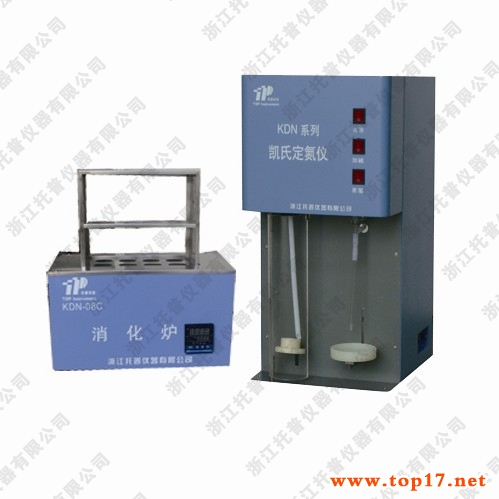The determination of nitrogen is a test that needs to be carried out in many industries such as food processing, grain, feed, water, soil, pharmaceuticals, tobacco, animal husbandry, soil and fertilizer, environmental monitoring, medicine, agriculture, scientific research, teaching, and quality supervision. Therefore, the professional instrument for the determination of nitrogen or protein content, the Kjeldahl, is widely used in these industries. In general, according to the different needs of the industry, the application of Kjeldahl in the laboratory will be different. Here's a brief introduction of the main applications of the Kay-Determination in the laboratory? The Kjeldahl meter is very versatile and covers a wide range of fields. In general, the main applications of the Kjeldahl meter in the laboratory include the determination of proteins; determination of nitrogen; determination of ammonium salts; volatile salts Determination of base nitrogen; Determination of formaldehyde content in water-based products; Determination of sulfur dioxide content, etc. It can be seen from the above that the Kjeldahl meter is mainly used to control the quality of products produced by enterprises, as well as environmental monitoring, etc. In practical work, Kjeldahl has indeed played its outstanding performance for companies or The work carried out by the relevant scientific research units brings real value and is a rare helper. As an important laboratory instrument using new technologies in chemistry, physics, electricity, and automatic control, the Kjeldahl nitrogen analyzer is not only simple to operate, safe to use, has high measurement efficiency, but also can batch process samples to satisfy modern experiments. The chamber measures the stringent requirements of high efficiency and high accuracy, and quantitatively measures the contents of nitrogen and protein in foods, crops, fertilizers, soils, water and other substances. Kjeldahl can accurately measure and objectively reflect the The protein content of the tested samples contributed to the development and progress of the industry. At the same time, with the development of domestic science and technology, the domestic K-type nitrogen determination instrument has also developed vigorously. It has brought a cost-effective, stable K-type nitrogen determination instrument to many companies and has met the needs of various industries. Different needs.
Rice Cooker
A rice cooker or rice steamer is an automated kitchen appliance
designed to boil or steam rice. It consists of a heat source, a cooking bowl,
and a thermostat. The thermostat measures the temperature of the cooking bowl
and controls the heat. Complex rice cookers may have many more sensors and
other components, and may be multipurpose. Cooking rice has traditionally
required constant attention to ensure the rice was cooked properly, and not
burnt. Electric rice cookers automate the process by mechanically or
electronically controlling heat and timing, thus freeing up a heating element
on the cooking range that had to be otherwise occupied for rice cooking.
Although the rice cooker does not necessarily speed up the cooking process,
with an electric rice cooker the cook's involvement in cooking rice is reduced
to simply measuring the rice, preparing the rice properly and using the correct
amount of water. Once the rice cooker is set to cook, the rice will be cooked
with no further attention.
Features:
For modern home
rice cookers, the smallest single-person model cooks 1 rice cup (180 ml),
whereas large models can cook 10 cups. Commercial models can cook 20 or more
cups. As a possible source of confusion, model specifications and names may
list either cooked or uncooked capacity. Rice roughly doubles in size during
cooking; therefore, a 10 cup (uncooked) rice cooker can produce up to 20 cups
of cooked rice. The prices vary greatly, depending on the capacity, features,
materials used, and the country of origin.
The majority of
modern electric rice cookers are equipped with a stay-warm or keep-warm feature,
which keeps the rice at an optimal temperature for serving without over-cooking
it. Some gas cookers also have electric stay-warm mechanism. However, the
usefulness of this feature degrades over time, a microwave may be more energy
efficient or better suited to reheat rice that will sit longer than four hours.
Some rice
cookers use induction heating, with one or more induction heaters directly
warming the pot. This can improve energy efficiency.
Most modern
rice cookers use aluminium for the inner cooking bowl. There are some models
that use stainless steel instead of aluminium. Various other materials, such as
copper, pure carbon, ceramic, and diamond powder coating, may be used for
higher heat conductivity or better taste.
The
pressure-cooking models can raise the water's boiling point higher, e.g., from
100 °C at 1.0 atm up to about 110 °C at 1.4 atm, which speeds cooking. The
pressure-cooking models can also be used in high altitude areas, where the
boiling temperature is below 100 Celsius. Pressure cookers are also suitable
for cooking brown rice (which contains oils and bran fiber that cook
differently from pure white rice starch). Some pressure rice cookers have a
varying pressure control mechanism (named the "dual-pressure" method)
that creates repeated pressure/release cycles during the cooking.
There also
exist mechanisms to collect and return the boiled over liquid to the inner rice
bowl.
Many cookers now have microprocessor-controlled cooking cycles, which are often used to adjust for rice and
cooking type.
Applications
Rice cookers are typically used for the preparation of plain or
lightly seasoned rice. Each rice cooker model may be optimized to cook a
certain type of rice best. For example, most Japanese rice cookers are
optimized for cooking Japanese rice and may not be the best for other types of
rice[citation needed], although cooking time can be lengthened simply by more
water.
The typical method of cooking long grain rice
is boil-and-strain and/or steaming method. The absorption method used in
Japanese rice cookers will produce slightly different texture and taste,
usually stickier rice.
Brown rice generally needs longer cooking
times than white rice, unless it is broken or flourblasted (which perforates
the bran).
Different varieties of rice need different
cooking times, depending on their grain size, grain shape, and grain
composition. There are three main types of Asian rice: Oryza sativa subsp.
indica, i.e., Indian rice (long grain rice, e.g., basmati rice and Thai jasmine
rice), O. sativa subsp. javanica, i.e., Java rice (large grain rice) and O.
sativa subsp. japonica, i.e., Japanese rice (medium grain rice, e.g., Calrose
rice, short grain rice, e.g., most Japanese rice and risotto rice).
African rice, Oryza glaberrima, is an entirely
separate species, but can be cooked in the same way. Zizania is not even in the
same genus, although it is often called a rice (or "water oats"); it,
too, can also be cooked in a rice cooker.
A
rice cooker can be used to cook many boiled or steamed granular foods, such as
pot barley, bulgar wheat, and dal. Provided the ingredients have similar
cooking times, a rice cooker can cook mixtures such as khichdi. Some rice
cookers can be used as automated couscoussiers, cooking couscous and a stew
simultaneously.
Rice Cooker,Drum Rice Cooker,Deluxe Rice Cooker,Straight Rice Cooker Guangzhou Taipeng Electrical Appliances Technology CO., LTD. , https://www.taipengelectrics.com
